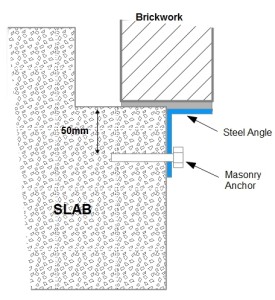Unfortunately brickwork overhanging the slab like this is more common than it should be. . . . but it’s often not the brickie’s fault.
How it Happens
Normally the problem is that the slab has been constructed smaller than the required dimensions.
This wouldn’t be a problem, but for the fact that most houses come with prefabricated frames which mean the frame is too big for the slab. If the frame components aren’t ‘adjusted’ to make them smaller they will overhang the slab, and as a consequence the bricklayer overhangs the brick to maintain the wall cavity.
How Much Is Too Much?
The Building Code of Australia (BCA), Part 3.2.2.7, Edge Rebates, states ‘Exterior masonry must not overhang more that 15mm past the edge of the slab’.
Interestingly the maximum overhang permitted for the frame is only 10mm from the edge of the slab.
Solution

To my mind the best solution is to bolt a steel angle to the slab using masonry anchors.
The reason the masonry anchor is 50mm from the top surface of the concrete is to prevent it breaking out.
I have heard of people suggesting pouring concrete, or a cement grout I wouldn’t recommend that. To do it properly would require dowel bars to be drilled into the concrete and reinforcement fixed before trying to bond a thin piece of concrete to the slab.